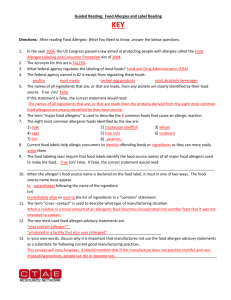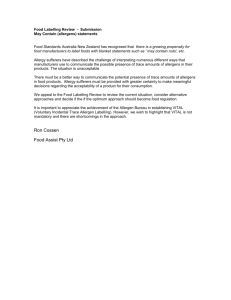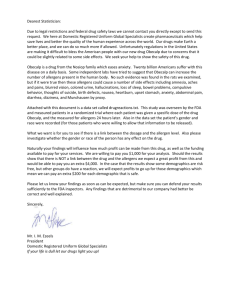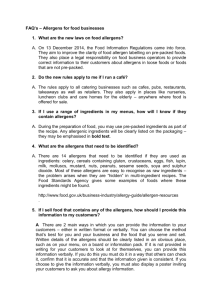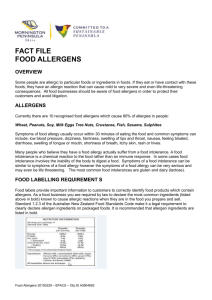Allergen Management
advertisement
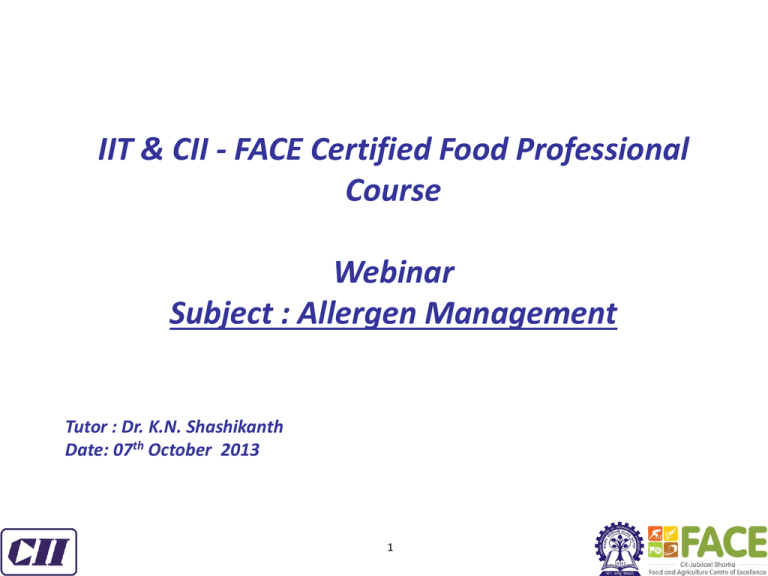
IIT & CII - FACE Certified Food Professional Course Webinar Subject : Allergen Management Tutor : Dr. K.N. Shashikanth Date: 07th October 2013 1 Allergen Management Allergen are substances, usually proteins which are capable of inducing an allergic reaction. Food allergens are typically naturally-occurring proteins in foods or derivatives of them that cause abnormal immune responses. Like Cereals, Crustacea, Eggs and egg products, Fish and fish products, Peanuts, soybeans, Milk and milk products, Tree nuts and nut products and Sulphite in concentrations of 10 mg/kg , more; and products of these; These proteins may be natural ingredients of the food products or may become part of a food through unintended exposure, as well. This may result from: – – – – – – – contamination of raw materials accidental mis-formulation changes to product scheduling rework insufficient or ineffective cleaning/sanitation procedures in-process cross contamination post-process contamination 2 Potential sources of Allergen cross contamination Raw material Handling Processing Aids Storage Transport Packaging People Supply chain CROSS CONTAMINATION Cleaning Air , water particles in the mfg. area Shared equipment Rework Others 3 Allergen Management Management practices adopted by Industry along its food supply chains to ensure that risk arising out of allergenic food products, due to its unintentional presences or delibrate addition as an ingredient is mitigated, when food reaches the consumers plate. These practices involve – Raw material sourcing, storage and communication to suppliers, – Transportation and storage of allergenic food products, – Production scheduling, Manufacturing and usage (as an ingredient or cross contamination) in products, – Manufacturing, eg cleaning procedures, control of rework – Equipment and premises design – Post-manufacturing controls – Employee training and supervision – Labelling and communication to consumers 4 What Are people most allergic to? As we now know that Food allergens are typically naturally-occurring proteins in foods or derivatives of them that cause abnormal immune responses. Prevalence of food allergies around the world is believed to be increasing, with more than 8% of children and 2% of adults in countries like Australia and New Zealand having allergy to one or more foods. Fortunately, many children outgrow their allergies by the time they have reached 5-7 years of age. Practically all foods have the capacity to cause an allergic reaction in a person who has become sensitized to that substance. More than 70 different foods have been described as causing food allergies. Several studies indicate that 75% of allergic reactions among children are due to a limited number of foods, namely egg, peanut, milk, fish and nuts. Fruits, vegetables, nuts and peanuts are responsible for most allergic reactions among adults. In Europe and the US peanut and nuts are the foods most commonly reported to cause life-threatening reactions. 5 Definitions Allergen :- A substance, usually a protein, capable of inducing an allergic reaction. Anaphylaxis/Anaphylactic Shock : - Acute form of allergy characterised by uticaria, swelling of the lips, shortness of breath, and rapid fall in blood pressure. Without immediate treatment which consists of intramuscular injection of adrenaline, anaphylaxis can be fatal. Antigen :- Substance, often protein in nature, capable of inducing an immune response, for example, a food allergen. ATPase Test: - A quick, simple test used to check the effectiveness of wet cleaning procedures. ATPase is an enzyme involved in cell metabolism in plants, animals and microbes and so, if it is detected, it shows that some organic matter is present, although it cannot be used to distinguish whether the ATPase comes from food residues or microbes. 6 Coeliac Disease: - A life-long autoimmune condition characterised by damage to the small intestinal wall due to intolerance to gluten protein present in wheat, rye, barley, oats, spelt, kamut or their hybridised strains. Consumer Testing: - This refers to product trials carried out in public places such as supermarkets etc. Co-products : -Products which are removed from the normal production chain for quality reasons, but which may still be sold for human consumption. Cross-Contamination : - The unintentional presence of another substance in the final product. In the context of allergens, it usually refers to trace amounts of allergenic foods which, whilst not of themselves unwholesome, may be problematic for those suffering from particular allergies. ELISA : - Enzyme Linked Immuno Sorbent Assay: a sensitive technique for the detection and measurement of compounds, including proteins such as food allergens. 7 Equivalent Standard: - The evidence to demonstrate little or no material of allergenic significance. This would include considering test results and processing/dilution factors. Food Allergy: -A reproducible adverse reaction to a food or food ingredient that involves the immune system, for example, allergy to peanut, nut, fish, shellfish, egg or milk. Food Intolerance : - A reproducible adverse reaction to a food or food ingredient that does not involve the immune system – for example, lactose. PCR: - Polymerase Chain Reaction: a sensitive method used to amplify a specific region of DNA (genetic material). 8 Which foods can cause allergies? The Codex Alimentarius Commission Committee on Food Labelling has listed the foods and ingredients that cause the most severe reactions and most cases of food hypersensitivity. General Standards for the Labelling of Prepackaged Foods states: “The following foods and ingredients are known to cause hypersensitivity and shall always be declared: • Cereals containing gluten; i.e., wheat, rye, barley, oats, spelt or their hybridized strains and products of these; • Crustacea and products of these; • Eggs and egg products; • Fish and fish products; • Peanuts, soybeans and products of these; • Milk and milk products (lactose included); • Tree nuts and nut products; and • Sulphite in concentrations of 10 mg/kg or more.” 9 Table of Allergens 10 Table of Allergens contd. 11 Table of Allergens contd. 12 Table of Allergens contd. 13 Table of Allergens contd. 14 Table of Allergens contd. 15 Table of Allergens contd. 16 Table of Allergens contd. 17 Table of Allergens contd. 18 Allergen declaration While the Codex list contains the major allergens on a world-wide basis, the prevalence of food allergies varies in different geographical areas. Some countries have chosen to include additional foods on their national list of foods and ingredients that must be declared on food labels. The EU for example has chosen to add celery, mustard and sesame seeds and products thereof to the list of allergens, which must appear on food labels. These are listed in detail in EU list of food allergens for labelling regulations (EC Directive 89/2003) We must remember This declaration applies when the listed products are present • • • • • as: an ingredient; or an ingredient of a compound ingredient; or a food additive or a component of a food additive; a processing aid or a component of a processing aid or as a Cross contact allergens 19 Cross contact allergens • Cross contact allergens occur when a residue or other trace amount of an allergenic substance is unintentionally added into a food not intended to contain that allergenic substance and where such occurrences are sporadic. • The guide provides recommendations on precautionary labelling where allergens may be present by cross contact and when indicated by VITAL 20 What are Food allergies? Definition Food allergies are the body's abnormal responses to harmless foods; the reactions are caused by the immune system's reaction to some food proteins. A food allergy is an adverse immune response to a food protein. They are distinct from other adverse responses to food, such as food intolerance, pharmacological reactions, and toxin-mediated reactions. Description Food allergies are often confused with food intolerance. However, the two conditions have different causes and produce different symptoms. A food allergy is also known as food hypersensitivity. The allergy is caused when a person eats something that the immune system incorrectly identifies as harmful. 21 Food allergies and Food intolerance Food allergies Allergic reactions to foods are characterised by the rapid release of powerful cellular chemicals such as histamine by the antibodies, which can occur within minutes or up to four hours after ingestion. Food allergies are usually mediated by immunoglobulin E (IgE) antibodies and can be confirmed by a skin-prick test or blood test. The immune system works to protect the body and creates food-specific antibodies. The antibodies are proteins that battle antigens, substances that are foreign or initially outside the body. The introduction of an antigen produces the immune response. Antibodies are created to destroy the antigen or counteract its effectiveness. The food that triggered that reaction is called an allergen. The antibodies are like an alarm system coded to detect the food regarded as harmful. The next time the person eats that food, the immune system discharges a large amount of histamine and chemicals. This process meant to protect the body against the allergen causes an allergic reaction that can affect the respiratory tract, digestive tract, skin, and cardiovascular system. 22 Allergic reactions to foods are characterized by the rapid release of powerful cellular chemicals such as histamine by the antibodies, which can occur within minutes or up to four hours after ingestion. Food allergies are usually mediated by immunoglobulin E (IgE) antibodies and can be confirmed by a skin-prick test or blood test. Food allergy symptoms vary in nature and severity between individuals and may include: – respiratory problems (rhinitis, asthma, throat swelling) – gastrointestinal problems (nausea, vomiting, diarrhoea, abdominal cramping) – skin problems (hives, itching, dermatitis, eczema). A severe reaction (anaphylaxis) can occur after contact/ingestion with allergens in foods. This can result in a rapid loss of blood pressure, severe obstruction of the airways, a generalised shock reaction and multiple organ failure. This can be fatal if not treated within minutes. While few people with food allergies are at risk of such serious consequences, some deaths have occurred following accidental ingestion of a food containing an allergen to which the individual is sensitive. 23 Food intolerance: - While food allergies involve the immune system, food intolerance is not related to the immune system. For example, a person who is lactose intolerant has a shortage of lactose, the digestive enzyme that breaks down the sugar in milk and dairy products. That person could experience stomach pain or bloating several hours after drinking milk. In contrast to food allergies, food intolerances are generally more common. People who are food-intolerant can sometimes consume that food and not experience intolerance symptoms. Reactions are more obviously dose-related, and include non-protein substances in foods. An intolerance reaction to a food may have delayed symptoms, with no observable effect for several hours after eating the food. There are no proven laboratory tests for food intolerances and diagnosis is through the use of an elimination diet. Symptoms can range from mild to severe and may include: • hives, eczema, other itchy skin rashes • stuffy or runny nose, asthma, frequent colds or ear infections • mouth ulcers, reflux, bloating, stomach aches, constipation and / or diarrhoea, incontinence • migraines or headaches • lack of concentration, anxiety, depression, lethargy, irritability, sleeping difficulties. 24 Coeliac disease : - Coeliac disease (pronounced as celiac disease in other countries) is an autoimmune disease, a reaction to dietary gluten. Gluten, which is found in wheat, barley and rye triggers an immune reaction in people with coeliac disease. This means that eating gluten damages the lining of the small intestine. Although Coeliac disease does not result in anaphylaxis, it causes damage to the intestine reducing the ability to absorb nutrients. Symptoms may appear at any time from early childhood to senior years. Treatment requires a strict, life-long gluten-free diet to allow the intestine to recover and to avoid complications. Possible symptoms may include: • diarrhoea, excessive wind, and/or constipation • persistent or unexplained gastrointestinal symptoms, such as nausea and vomiting • recurrent stomach pain, cramping or bloating • tiredness and/or headaches • weight loss (but not in all cases) • mouth ulcers • hair loss (alopecia) • skin rash (dermatitis herpetiformis (DH)) • tooth enamel problems • Osteoporosis and depression • joint and/or bone pain • neurological (nerve) problems such as ataxia (poor muscle co-ordination) and neuropathy (numbness and tingling in the hands and feet). 25 Allergen Risk Assessment, Management Communication along the Food chain. and In order to avoid the unintentional presence of allergenic foods in products it is necessary to evaluate the likelihood of unintentional allergen crosscontamination across the supply chain, from raw materials through to the finished product. Following completion of such a risk analysis, manufacturers can then determine whether or not allergen advisory labelling is appropriate on the finished product as sold to consumers. Risk analysis is made up of four stages: 1. Risk assessment– what is the risk? 2. Risk management – can the risk be managed? 3. Risk communication – how should the risk be communicated? 4. Risk review – has the risk changed? 26 Allergen Risk Assessment First Step The first step in the risk assessment process is to consider if the ingredient/product intentionally contains an allergenic foodstuff, and whether any of these allergenic ingredients have the potential to cross contaminate either foods produced on the premises, or ingredients coming into the premises. The allergens identified by legislation must be identified and Other allergenic foods, for example, lupin, molluscs, kiwi fruit, may be added depending on the prevalence of adverse reactions in sensitive consumers and their inherent potency to trigger severe reactions Second step The second step in the risk assessment process will identify the probability of unintentional presence of allergens, by thinking about how crosscontamination could happen and how likely it is to happen 27 Allergen Management with an organization Many foods containing known allergens must be labelled according to regulatory requirements in the Code. Food allergens can become part of a food through unintended exposure. This may result from: • inadvertent presence in raw materials • processing aids (e.g. enzymes) • incorrect formulation • changes to product scheduling • rework • insufficient or ineffective cleaning/sanitation procedures • in-process cross contact • post-process contact. The recommended approach to allergen risk management is through a Hazard Analysis and Critical Control Point (HACCP) program. This involves evaluating the hazards associated with the whole ‘lifecycle’ of the product, starting with the production of raw materials and assessing every step of the process through to labelling and packaging of the final product for consumption. The critical points where allergens can be introduced into products during manufacture should be identified, and a system established to monitor these critical control points, to ensure that unintentional cross contact is minimised. 28 Allergen Management - Key areas for consideration 29 Controlling allergens at source Raw materials Raw materials may contain allergens that are inadvertently present. This may occur at the supplier’s site prior to the ingredient reaching your plant or it may occur as a result of cross contact within your manufacturing plant. Suppliers should have good allergen management practices to minimise the risk of cross contact between raw materials. Allergen information should be provided by the suppliers of each raw material to identify any products that contain allergens, or that are derived from allergenic foods, or have a high likelihood of cross contact with allergenic substances. Any change to supplier or suppliers’ source should trigger a review of allergen status. Alternative ingredients should be treated like standard ingredients, with all information necessary provided so the manufacturer can avoid unintentional introduction of allergenic raw materials, or can take into account the need for allergen declarations for alternative ingredients when developing labels. 30 Premises • The manufacturing plant, where possible, should be designed to assist in allergen management. • Manufacturers producing at more than one site might consider consolidation of products containing like allergens to one location, or create sites free from specific allergens. • Separate production equipment and tools should be used to establish a clear distinction between products containing different allergens and those that do not contain allergens. 31 Storage and distribution • Manufacturers should identify all allergenic materials upon receipt at a plant. These should be segregated from non-allergenic materials, and ingredients with different allergens should be segregated from each other. • Ingredients should be stored to avoid the potential for spillage onto other ingredients, such as placing allergenic ingredients on shelves below other ingredients. • Materials should be clearly labelled to identify the name of the ingredient, the presence of allergens and specify the type of allergens present. • Care must be taken in the storage of finished products to avoid cross contact with raw materials. 32 Manufacturing process • To minimise the potential for unintentional allergen cross contact of product, allergen management practices should be part of good manufacturing practices (GMP) and HACCP-based food safety systems. • When ingredients are selected for use in product manufacturing, the ingredients and their product information should be checked against the design criteria to ensure they are suitable for the product to be manufactured. • Where possible, a production system should be designed to minimise the potential for cross contact. • Monitoring systems should be in place to ensure that cross contact does not occur. Manufacturers should use dedicated manufacturing tools or equipment for specific allergen containing products to minimise any chance of cross contact. • Production schedules should be organised to process allergen free products at the beginning of the schedule, with allergen containing products run at the end of the production schedule and followed immediately by the cleaning cycle. • Appropriate scheduling and longer runs can also minimise the potential for allergen cross contact. Clearly defined allergen clean up procedures should be in place on the manufacturing line and in the event of raw material spills. 33 Rework • Rework policies and procedures are required to minimise the risk of allergen cross contact. • Rework that contains allergenic ingredients should not be included in material that would otherwise be free of that allergen. • Rework should be clearly labelled so it can be identified. • A procedure for tracking rework through to a finished product is an important element of an allergen risk management program. 34 Filling and packing • Controls established for allergen risk minimisation should ensure correct packaging/labels are used for the appropriate product. • Care must be taken when variant labels in the same range are used as they may be very similar in colour and graphics. • Similarly where blank inners are stored as work in progress for extended periods. Special care must be taken to ensure appropriate labelling is applied and different inners are not mixed. • Technological options available to assist in tracking and identifying materials include using internal bar coding, radio frequency identification, or imaging for verification. • Appropriate controls such as a simple checklist or match procedure, which are signed off by the responsible production operative, should be in place. 35 Equipment and line design • Ease of cleaning should be a consideration when purchasing new equipment and installing or re-laying production lines. • Avoiding line crossovers, allowing adequate space for effective cleaning and eliminating “dead legs” and “hang-ups” are important ways to minimise the risk of allergen cross contact. • Dust minimisation and/or physical barriers between lines will also reduce the risk of cross contact. 36 Cleaning • Documented and validated cleaning procedures are critical for avoiding unintentional allergen cross contact. • Adequate time must be allowed for cleaning and verification. • Re-cleaning may be required if verification shows initial cleaning has not been adequate. • Cleaning short-cuts could lead to product build-up in the manufacturing equipment. • To ensure successful cleaning it is necessary to consider: – documented cleaning procedures – training of cleaning personnel and operators – knowledge of the system to identify hidden or static areas – knowledge of the allergen status of the products – effective cleaning equipment and supplies – dismantling equipment to remove allergen residues – cleaning verification e.g. visual inspection, sampling or testing for allergen residues minimise use of air guns and water hoses to avoid distributing allergens within the plant. 37 Training and supervision Employee awareness and training is critical to avoid the unintentional or undeclared presence of allergens in products. Training of all staff working within a production facility is essential to control potential sources of food allergen risk. Training should provide an awareness of food allergens and the consequences of unintentional consumption by allergic consumers. Staff should receive training on best practice in allergen management specific to their site, the products they handle and their responsibilities. Some key areas food companies need to consider when providing training in allergen risk management include: – receipt and storage of raw materials – avoiding cross contact of non-allergenic ingredients with allergenic materials, or between different allergenic ingredients – production scheduling – equipment and premises design – good manufacturing practices, for example: cleaning procedures, control of rework – post-manufacturing controls – new product development. 38 Food companies should have an Allergen Management Policy, and all staff need to be aware of their responsibilities. Staff should be encouraged to report any suspected breaches to the relevant area supervisor, and to suggest possible improvements. All procedures undertaken for allergen management should be documented and signed by a qualified supervisor. Trained internal compliance auditors should regularly assess these records as part of the company’s food safety program. Formulation and labelling controls • Regular internal audits of production systems should be conducted to verify that the product formulation matches the records of ingredient use and that the composition of the final product is accurately reflected in the ingredients specified on the label. • Internal audits should also verify the VITAL assessment, even when the precautionary statement is not on a label. • If there is a formulation change, or change to raw material supplier that results in the introduction of new allergenic materials, then existing labels must not be run out. 39 Testing and Analysis of Allergens Testing for food allergens is a valuable tool when used as part of a risk–based approach to allergen management. Test results can provide assurance and verification of critical controls within a comprehensive risk management program. The most commonly used analytical method for detecting the presence of food allergens is the Enzyme Linked Immuno Sorbent Assay (ELISA) technique. The sensitivity of ELISA kits currently available is in the low parts per millions (ppm) reporting range. While there are many benefits to using the ELISA method, there are some limitations to using and interpreting results which must be considered. These may include: – protein extraction for analysis – effect of food processing – protein structure – cross reactions – availability of kits for different allergens. A number of allergen ELISA test kits are currently available and international research is being conducted to develop alternative or confirmatory methods for the routine detection of allergens in foods. Rapid ELISA test strips for allergen detection are also becoming more widely available and in some instances these may be suitable for allergen screening in-house during production, although these are not as sensitive as current ELISA test kits. 40 DNA-based detection, based on Polymerase Chain Reaction (PCR) techniques, is growing in popularity. It requires sophisticated laboratory conditions Results need to be carefully interpreted to avoid false positives. This is because of the absence of threshold levels, the fact that this method detects DNA from the allergenic source food and not the protein itself, and it is both highly sensitive and lacks quantification. Swabbing techniques are currently only used in conjunction with immunoassay kits, but may have the potential to be extended to DNA detection. These can be particularly useful tools in the validation and ongoing verification of allergen risk management plans, particularly cleaning regimens. In the manufacturing environment, where time and/or analytical capabilities may be limited, raw materials, environmental swabs or final products can be tested using rapid, simple immunoassays within a few minutes to give simple visual readouts of the presence or absence of the allergen. However, some of these tests are significantly less sensitive than laboratory methods. Another rapid test which measures the presence of ATPase. A positive with this method is an indication only of the presence of protein in general, rather than the presence of specific proteins from an allergenic food. This test can be used for checking general cleaning efficiency but a positive result cannot give information on which protein is present. Rapid tests are available for gluten and more recently rapid tests for peanut have emerged. Recent developments in the application of gluten testing have resulted in new, more sensitive methodology. 41 Allergen Risk Communication Advisory labeling: - when communicating with allergic consumers labelling point of sale information, leaflets and websites, consumer should be advised always to refer to the ingredient list. An advisory labelling should in close proximity to the ingredient list. It is recommended that there is a close distinction in the labelling information provided between ingredients that are deliberately added components to the food and any possible allergen cross contamination, arising from production of raw ingredients or during the manufacture or transport of the food. These panels are not a legal requirement but, where such information is given, it is best practice to associate it clearly with the ingredients list. If such devices are employed, all allergenic foods or ingredients as defined by law and used in the food should be listed in such a box, panel or statement. If using a box headed, for example, ‘Allergy Advice’, make sure that there is a clear distinction between allergens that are deliberate ingredients and those that are possible cross-contaminants. 42 Advisory labelling on possible cross-contamination with allergens should be justifiable only on the basis of a risk assessment applied to a responsibly managed operation. Warning labels should only be used where there is a demonstrable and significant risk of allergen cross contamination, and they should not be used as a substitute for Good Manufacturing Practices. Consumers prefer to be presented with the facts, which would allow them to make their own decision on whether or not to eat the food. Possible phrases to be used to convey allergen advisory information such as ‘Not suitable for’; ‘ May contain’ or ‘Not recommended for’. Manufacturers may make such without making medical judgements for individuals. Some other made similar suitable statements, considering the difficulties in communicating the risk-based approach behind using an allergen advisory statement. 43 Consumers may be allergic to a particular type of allergenic ingredient or product like nuts or some specific sub product like – tree nuts or peanuts. Consideration should therefore be given to whether it is possible on the label to indicate the species of nut involved. Where a product contains peanuts but may be cross-contaminated with tree nuts, it may be appropriate to use a phrase such as ‘May Contain Other Nuts’. If an allergenic food, or a derived ingredient, is listed in the ingredients list it is not necessary to additionally provide allergen advisory labelling for possible crosscontamination with the same source allergenic food. For example, if an Indian-style ready meal contained peanuts, it would not be necessary to use warning labelling that some of the ingredients used in the sauce may contain peanuts. Advisory statements need to be easily visible and clearly legible. Fonts should be simple. 44 Allergen Risk Review Allergen Management Systems should be monitored and reviewed to provide assurance that they are working correctly. The most effective way of doing this is by carrying out routine checks on manufacturing operations including an audit or ‘health check’ of the system. An overall health check’ can find any weaknesses in the system and then corrective actions can be taken. A key benefit of auditing the system is to provide evidence of due diligence in managing allergens. – Review and verification of the hazard analysis and hazard management system. – Product and ingredient specifications. – Operating procedures. – Cleaning procedures. – Training records – demonstration of competence. – Analysis of customer complaints. – Customer complaints should be investigated and changes made where necessary. 45 The frequency of review will depend on the risk level of the operation. An annual review is likely to be reasonable in most circumstances. However, any of the following may trigger the need to conduct a review: • Introduction of new ingredients, new recipes or new processes, Changes in scheduling, equipment, site, source of raw material, product storage, handling or manufacture, • EFSA will be reviewing the list of allergens for mandatory ingredients listing, so new allergens may emerge that will need to be managed, or • Any other changes which introduce significant risks. • Any changes to one process within a food production area or introduction of a new product, can affect the risks of allergen cross contamination of other products manufactured at the same site. Moving production of a product to another site may also result in a different allergenic risk, which needs to be relayed to the consumer. • • Following any such changes, it will be necessary to conduct a new assessment of the risks of allergen cross-contamination of a product, including an evaluation of any advisory labelling that might be necessary. 46 Conducting Allergen assessment Manufacturers and their suppliers must conduct periodic Allergen assessments to verify the preparedness of the Allergen Management System to ensure that Food Allergen are not passed on to consumers causing any risk to their health and safety. EXAMPLE - 1 ALLERGEN CHECK LIST FOR FOOD SUPPLIERS AND MANUFACTURERS • • • Column I indicates the allergens that may be found in the product, from addition or cross-contamination. Column II indicates the allergens present in other products that are run on the same equipment but at a different time. Column III indicates whether any allergens are present in your plant. Please fill in each cell of the table with a YES or a NO and, when applicable, include the name of the ingredient. Do not leave empty cells. 47 Column I Component Column II Column III Present in Present in Present in Product other the same products mfg. plant mfgd. on same line Cereals like Wheat or their derivatives, e.g., flour, starches and brans etc. Includes other wheat varieties such as spelt, durum, kamut, emmer etc. Crustaceans (including crab, crayfish, lobster, prawn and shrimp) and Shellfish (including snails, clams, mussels, oysters, cockle and scallops) or their derivative, e.g., extracts etc. Eggs or its derivatives, e.g., frozen yolk, egg white powder and egg protein isolates etc. Fish or its derivatives, e.g., fish protein, oil and extracts etc. Peanut or its derivatives, e.g. Peanut – pieces, protein, oil, butter flour, etc. May also be know as ground nut. Soya or its derivatives, e.g., lecithin, oil, tofu and protein isolates etc. 48 Component Milk or its derivatives, e.g., milk caseinate, whey and yogurt powder etc. Tree Nuts (almonds, Brazil nuts, cashews, hazelnuts (filberts), macadamia nuts, pecans, pine nuts, pistachios and walnuts or their derivatives, e.g., nut butters and oils etc. Sesame or its derivatives, e.g., paste and oil etc Sulphites, e.g., Sulphur metabisulphites etc. dioxide and Sodium Others (as considered necessary – like Mustard or Black gram) 49 Column I Column II Column III Present in Product Present in other products mfgd. on same line Present in the same mfg. plant Questions..? 50 50 Thank you for your kind attention 51 51
